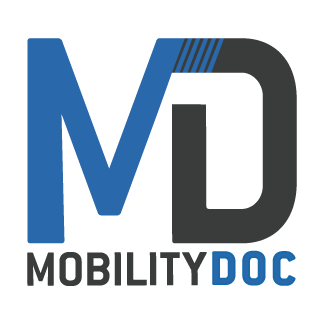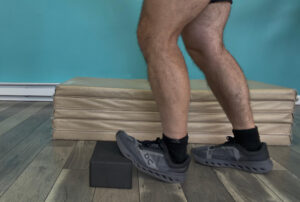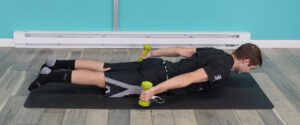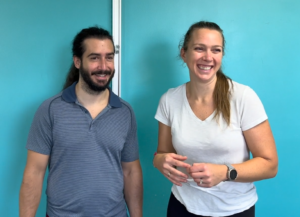When back pain strikes, you want relief as quickly as possible. Thankfully, there are three tools which provide immediate relief you can use right at home. Most of us already own at least 1 of these! Percussion therapy from a massage gun can help release tightness, foam rolling targets the muscles along your back to reduce tension, and using an acupressure cane can stimulate pressure points to relieve deep muscle soreness. These techniques are quick, easy, and incredibly effective for reducing pain and improving movement. Let’s dive into how to use these tools properly, so you can experience fast back pain relief and get back to your normal activities with less pain.
Improve Mobility First
When dealing with back pain, it’s tempting to jump right into strengthening exercises in hopes of fixing the problem and reducing discomfort. However, there’s an important step to take before you start strengthening your muscles: you need to first address the pain. Why? Pain hinders proper movement. When you’re in pain, your body’s natural response is to compensate by altering your movements reducing the pain you feel. This can lead to inefficient patterns. These inefficiencies not only prevent healing but can also create new injuries. If you try strengthening your muscles while in pain, you risk reinforcing those faulty patterns, potentially making things worse. That’s why our first steps to lasting back pain relief are techniques focused on improving range of motion and myofascial release. Now let’s get down to breaking up muscle tension and knots!
Back Pain Relief Techniques:
Percussion Therapy
Percussion therapy, or a massage gun, is an excellent way to provide myofascial release to the lower back and hips. The vibrating action from the massage gun helps improve circulation, and release muscle tension. Here’s how to effectively use a massage gun for back pain relief:
Step-by-Step Guide:
- Choose the right attachment: We like using the soft “plunger” shaped attachment for larger muscle groups, such as the lower back and hips. This will provide a more diffused feeling if you’re in a lot of pain. Don’t worry, this more generalized pressure will still help to loosen those tight muscles.

- Start with a low setting: You can do this either seated or standing, whatever you prefer. It’s always important to begin at a low speed to gauge your tolerance, especially if you are in a lot of pain. Gradually increase the intensity as needed.
- Target the lower back: Gently place the massage gun on the paraspinal muscles (muscles that run along either side of your spine). Move slowly up and down your back scanning the entire area. Avoid applying direct pressure to the spine itself, as this can be uncomfortable but you shouldn’t necessarily harm yourself.
- Work the hips and glutes: Lots of times our low back pain is actually being caused by tight glutes! Using the massage gun on the gluteal muscles can be just as effective in relieving pain.
- Holding: As a rule of thumb you want to scan the area for 2 minutes before holding on any extra tight or uncomfortable spots. You can feel free to hold on 2-3 spots for about 30 seconds each but don’t over do it!
Foam Rolling
One often overlooked area in back pain relief is the thoracic spine (the middle portion of your back). Tension in the thoracic spine can affect posture and contribute to pain in the lower back and shoulders. Foam rolling is a great way to release this tension and improve mobility.

Step-by-Step Guide:
- Position the foam roller: Start by placing the foam roller on the floor and lying on your back. Place the foam roller right at the bottom of your rib cage. This should be the where your lumbar meet your thoracic spine.
- Support Yourself: Keep your knees bent and feet flat on the floor. Place your hands behind your head to help support your neck
- Roll slowly: Lift your hips off the ground slightly and roll your upper body forward and back over the foam roller. Focus on areas of tightness or discomfort in the middle back. You don’t want to go into the low back so make sure you stop at the bottom of your rib cage.
**This can be more intense for people. If it feels like a lot, remember you control the pressure.
- Want more release?: Begin at the base of your rib cage and slowly lower your upper body over the roller, sit up and scoot yourself forward by an inch. Keep moving slowly up 1X1 until you’ve tried to get all 12 vertebrae!

- Don’t forget the hips! Just like we started getting into those hips and glutes with the massage gun this technique isn’t any different. We want to foam roll the hips and glutes for back pain relief as well.
Using an Acupressure Cane for Targeted Release
An acupressure cane is a self-massage tool that allows you to target specific pressure points in the lower back, upper back, and hips. It’s ability to target small areas can provide deeper relief where it’s needed most. It works similarly to acupressure or trigger point therapy. By applying sustained pressure to areas of tight muscle or fascia it releases tension. The best part about this tool is that it can get hard to reach areas!
Step-by-Step Guide:
- Position the cane: Hold the acupressure cane with both hands and place the end against the muscle knots or tight spots in the lower back or hips. Common areas to target include the glutes, paraspinals, and sacroiliac joint.
- Apply pressure: Apply gentle, consistent pressure for 30-60 seconds on the tight spot. If you find a particularly tender area, pause and allow the cane to release the knot before moving to another area.

- Move the cane: Continue exploring and find more tight spots that need to be worked like above. You can go up all the way into the upper back and shoulders which makes this tool so versatile for DIY!
For More Tips Watch Our How To Video About Back Pain Relief
When dealing with back pain, relief is the first priority. Tools like the massage gun, foam roller, and acupressure cane provide effective, immediate solutions for releasing tension, improving mobility, and reducing pain. By addressing muscle tightness and improving circulation, you create a foundation for strengthening exercises that will help prevent future pain and improve your overall function. Start with these myofascial release techniques, and you’ll be well on your way to feeling better, faster
Stay Tuned!
You don’t think we’d leave you hanging with just mobility exercises did you? No way! We have a part 3! We’ll be releasing some amazing strength exercises to reduce and hopefully take your back pain away for good! This little break gives you some time to really focus on improving mobility and relieving that pain. If you have any questions or comments please reach out on any of our social media accounts. We’d love to hear from you!
Are Tight Hips Causing Your Back Pain?
Whether it’s your hip flexors or glutes, one of the most common causes of back pain are tight hips! When your hip muscles get too tight it can cause your pelvis to tilt one way or the other causing low back pain. Common causes of this are lack of stretching after physical activity, or being seated for long periods of time among other things.
No matter how your hips got tight, the good news is that it’s a simple fix! MDRx Hips uses the Mobility-Doc method to improve the overall mobility of your hips.
You’ll Improve:
Flexibility – for ease of movement
Stability – to secure your new found range of motion
Strength – to move with ease and confidence!
For the next 4 week’s you’ll spend 15 minutes a day improving the movement patterns of your hips to help you achieve lasting pain relief.





